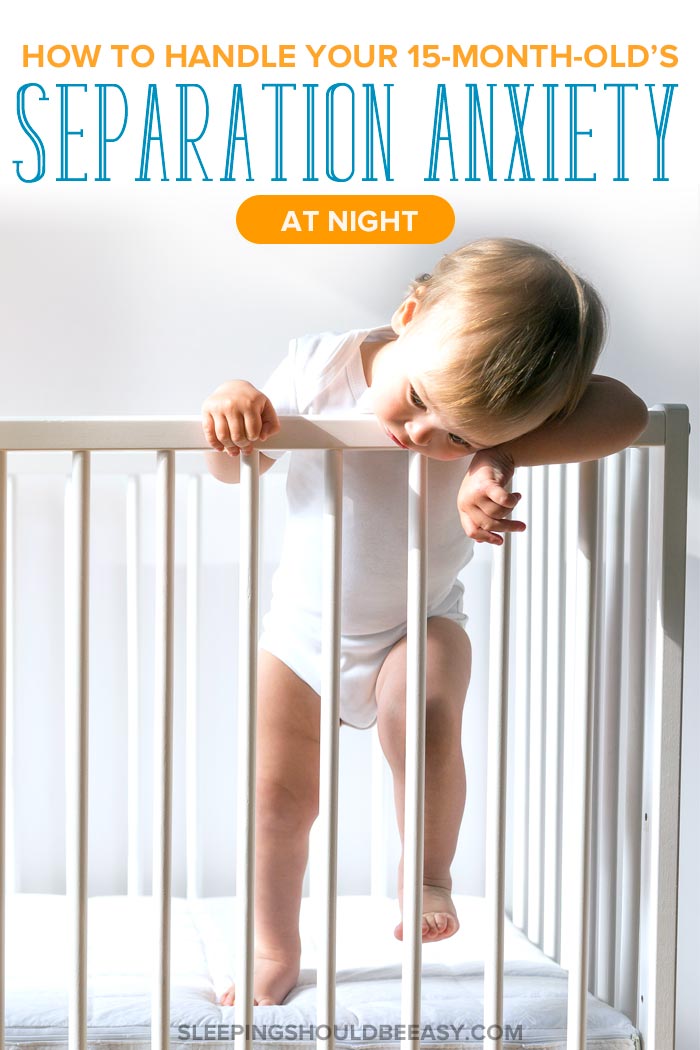How to Handle Your 15 Month Old’s Separation Anxiety at Night
Toddler can’t sleep through the night without you? Learn how to handle 15 month old separation anxiety at night and stop the sleep regression.
 It’s been a whole month now.
It’s been a whole month now.
Your toddler, who normally sleeps through the night, is suddenly having separation anxiety. Getting him to sleep come nighttime is taking a while. He clearly doesn’t want you to leave the room, and you’ll often find him standing in the crib, facing the door and crying for mommy or daddy to come back.
You’ve been staying in his room until he sleeps, but this only makes him to be more alert and restless (since he keeps peeking to check that you’re still there). And even this is only effective if he has completely fallen asleep before you leave.
So much so that you’ve sometimes given in and had him sleep in your bed for the rest of the night, or rocked him to sleep just so you could all finally rest. But as you know, this can’t turn into a habit.
Other times, you’ve lucked out and he actually falls asleep on his own when you put him down at bedtime. But he loses it when he wakes up in the middle of the night and finds that you’re no longer there.
Signs of his separation anxiety spills into the daytime as well. He’s extra clingy during the day if you’re not carrying or playing with him. And of course, the lack of sleep only means that early waking is all that more common the next day.
When your 15 month old has separation anxiety at night
Hardly anyone sleeps when your toddler refuses to go to bed or wakes up throughout the night because he’s alone. As heartbreaking as it is to see him upset, you also know that these night wakings can’t keep going on like this, that something has to change.
The 15 month old separation anxiety at night is a normal sleep regression, but thankfully you can still do plenty to help him cope with his big emotions. Take a look at a few tactics I tried when my kids went through this phase. Hopefully you’ll find a few that work for you:
1. Practice object permanence
Infants and toddlers learn the concept of object permanence gradually. At some point, often around 3 years old, they learn that objects (and people) continue to exist even if they don’t see or hear them.
So, when your 15 month old can’t see anything in the dark, or sees you leaving his room, he may not know that you’re still, say, in the living room.
One way to help him understand object permanence is to play peek a boo. You might cover your face with a blanket, or cover a toy with one, before making the big reveal.
Another fun way is to hide objects and make it a game to search for them in spots he can easily find himself. You might hide a toy behind another one, or tuck a book face forward on the shelf. Ask him to find the toy or book, perhaps giving him clues on where they might be.
Free resource: Struggling with putting him to sleep? Teach him to self soothe and sleep on his own. Whether you’ve tried to teach him in the past or are just now considering it, take a look at the 5 key mistakes to avoid. Join my newsletter and grab this resource below—at no cost to you. As one parent said:
“Thank you for the chapter. I was telling my husband this is the first site that didn’t make me feel like a bad mom.” -Kyleigh Burtner
2. Have a consistent bedtime routine
Has your routine been sliding these days (or have you not really had one to begin with)? Having a regular sleep schedule gives your toddler the predictability he needs to transition to sleep. With his nights so familiar and routine, he doesn’t have to spend energy feeling anxious about what comes next.
So, what does consistency during the bedtime routine look like?
For one thing, start the routine at the same time every night. Then, do the same activities in the same order. That might mean giving him a bath, followed by dressing him in pajamas, reading two books, and turning on the night light—every night. Having a ritual of familiar activities can ease him to better sleep.
Take a look at these examples of a 15 month old sleep schedule.

3. Give your child a special lovey
Disclosure: This article contains affiliate links, which means I will earn a commission—at no extra cost to you—if you make a purchase.
Help your child develop an attachment with special toys like a lovey or stuffed animal. A comfort object can help him cope with big feelings and not feel so alone.
All three of my kids had their own lovies that they slept with during each nap time and bedtime. They’d hold and even suck on the corners of the small blanket to help them fall asleep. This was one of the ways they coped with separation anxiety, knowing they had a familiar and comforting item with them.
4. Add light to your child’s room
Your child might feel extra anxious in a dark room. One way to help him see familiar objects is to add a night light to his room. The light is soft enough that he can still sleep, but prevents the room from being pitch dark.
Another way to add light is to turn the hallway light on for, say, the first hour after he’s in bed. You might even leave the door ajar so that more light can peek inside. That way, he feels like he’s not alone in the dark, and that you’re not too far away.
Expert tip
Add white noise to his room to muffle sudden sounds that can startle him awake. You can use a fan, heater, white noise machine, or even an app. The comforting sound can lull him to sleep and allow you to walk around the house without fearing you’ll wake him up.
Is your 15 month old awake for hours at night? Here’s what to do.

5. Keep goodbyes quick, calm, and confident
How do you say goodbye to your little one at night? If you’re like me, you might be tempted to spend considerable time consoling his tears, as if you’re leaving him to his worst fate possible. You can only imagine how distraught he might feel seeing you equally upset that it’s bedtime.
Instead, exude a sense of calm and confidence in saying goodbye. Show compassion for his feelings so he feels heard, then stay calm so he can model your behavior. Show confidence that everything is fine, and that he’s exactly where he needs to be.
And finally, don’t linger too long hoping he’ll calm down. Even if you spend a long time consoling him, he’ll probably get riled back up the minute you leave. Instead, leave quickly and confidently, especially since you know that he’ll be fine where he is.
6. Check in at set times
How do you give your child a chance to sleep on his own while still giving him the reassurance that you’re here? Check in on him, but do so at set times.
Let’s say you’ve closed the door but he’s still crying. Check in on him five minutes later to let him know that it’s still time to sleep and that you’re in the living room. Then, close the door and, if he’s still crying, check in again in 10 minutes. Reassure him once more, and again, check in, this time in 15 minutes.
This way, he learns that he can sleep without you in the room, but that you’re still here checking in on him frequently.
Expert tip
Use a baby monitor to keep an eye on him between check-ins. That way, you can see what he’s up to without having to open the door and peer inside.
Conclusion
As if bedtime wasn’t hard enough, nighttime separation anxiety adds a new level of complexity. Thankfully, you can ease your child’s worries and anxieties and help him sleep well once again.
Start by practicing object permanence so he understands that people and surroundings are still here even if he can’t see them. Have a consistent bedtime routine to give him a sense of familiarity leading up to sleep. Give him a special lovey he can hold onto, especially when he’s in bed away from you.
If he’s afraid of the dark, add a night light to his room, or leave the door slightly ajar. Be mindful of your goodbyes and try to keep them quick, calm, and confident. And finally, check in at set times, not whenever he wakes up crying. That way, he knows it’s time to sleep, but that you’re still here to check on him.
Now you and your toddler can get the sleep you need—no more staying in his room until he falls asleep!
Get more tips:
- How to Deal with the 12-15 Month Sleep Regression
- Children’s Books about Separation Anxiety
- How to Deal with Separation Anxiety
- When Your Toddler Has Sudden Separation Anxiety at Bedtime
Don’t forget: Join my newsletter and grab 5 Mistakes That Keep Your Baby from Self Soothing below—at no cost to you:

